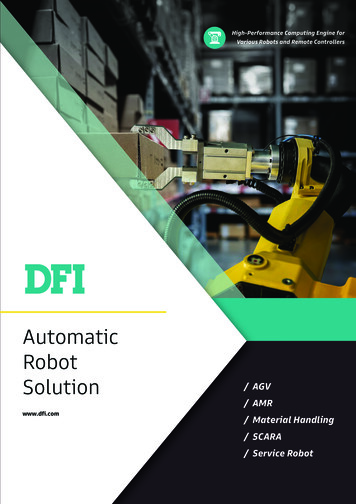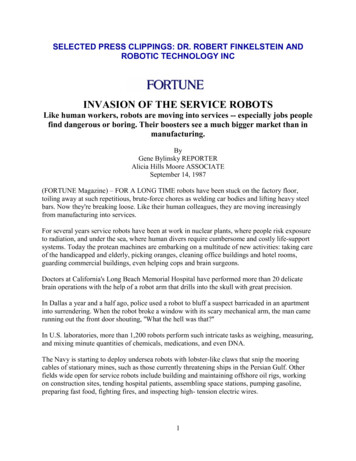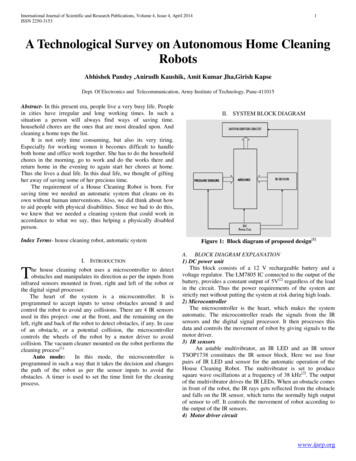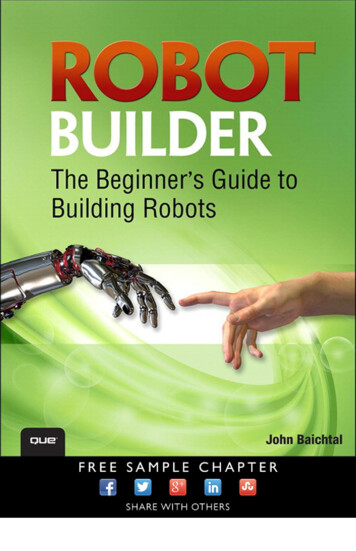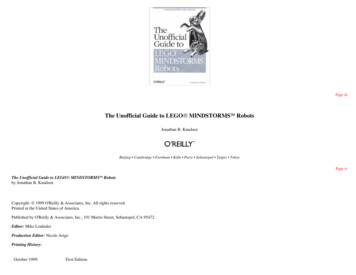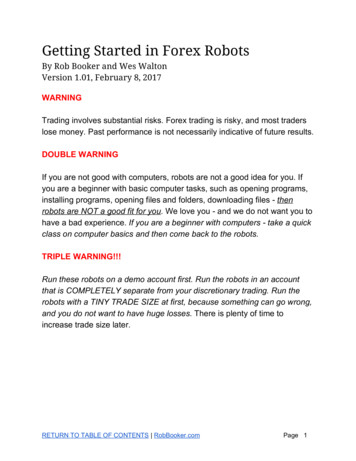
Transcription
Programming with RobotsAlbert W. SchuellerWhitman CollegeOctober 12, 2011
2This work is licensed under the Creative Commons Attribution-NonCommercial-ShareAlikeLicense. To view a copy of this license, visit http://creativecommons.org/licenses/by-nc-sa/3.0/ or send a letter to Creative Commons, 543 Howard Street, 5th Floor, SanFrancisco, California, 94105, USA. If you distribute this work or a derivative, include thehistory of the document. This text was initially written by Albert Schueller and supportedby a grant from Whitman College, Walla Walla, WA USA.Thanks to Patricia “Alex” Robinson for reading this over and helping me to keep it clean.
Chapter 1Introduction1.1External ReferencesThroughout these notes the reader is directed to external references. Unless otherwise specified, these external references were all created by the developers of the RobotC software atCarnegie-Mellon’s Robotics Laboratory. The materials are distributed with the software andare copyrighted and unedited. Because RobotC is still actively being developed, there arecases in which the documentation does not match the RobotC behavior. The references arestored locally to improve access to the materials and to ensure that they match the versionof the software that we are using.1.2Why Robots?Why learn the basics of programming using robots instead of more traditional method? Forthe last 50 years mainstream computer science has centered on the manipulation of abstractdigital information. Programming for devices that interact with the physical world hasalways been an area of specialization for individuals that have already run the gauntlet ofabstract information-based computer science.In recent years, we have seen a proliferation of processing devices that collect and manageinformation from their real-time environments via some physical interface component–amongthem, anti-lock brakes, Mars rovers, tele-surgery, artificial limbs, and even iPods. As thesedevices become ubiquitous, a liberally educated person should have some familiarity withthe ways in which such devices work–their capabilities and limitations.3
4CHAPTER 1. INTRODUCTION
Chapter 2Hardware and SoftwareMuch of computer science lies at the interface between hardware and software. Hardwareis electronic equipment that is controlled by a set of abstract instructions called software.Both categories have a variety of subcategories.2.1HardwareComputer hardware is typically electronic equipment that responds in well-defined ways tospecific commands. Over the years, a collection of useful kinds of hardware has developed:1. Central processing unit (CPU) - a specialized integrated circuit that accepts certainelectronic inputs and, through a series of logic circuits, produces measurable computational outputs.2. Random access memory (RAM) - stores information in integrated circuits thatreset if power is lost. The CPU has fast access to this information and uses it for“short-term” memory during computation.3. Hard disk drive (HDD) - stores information on magnetized platters that spin rapidly.Information is stored and retrieved by a collection of arms that swing back and forthacross the surfaces of the platters touching down periodically to read from or writeto the platters. These devices fall into the category of “secondary storage” becausethe CPU does not have direct access to the information. Typically, information fromthe HDD must be loaded into RAM before being processed by the CPU. Reading andwriting information from HDD’s is slower than RAM.4. Other kinds of secondary storage - optical disks like CD’s or DVD’s where light(lasers) are used to read information from disks; flash memory where information isstored in integrated circuits that, unlike RAM, do not reset if power is lost; all of theseare slower than HDD’s or RAM.5. Video card - is a specialized collection of CPU’s and RAM tailored for renderingimages to a video display.5
6CHAPTER 2. HARDWARE AND SOFTWARE6. Motherboard - a collection of interconnected slots that integrates and facilitates thepassing of information between other standardized pieces of hardware. The channelsof communication between the CPU and the RAM lie in the motherboard. The rateat which information can travel between different hardware elements is not only determined by the hardware elements themselves, but by the speed of the interconnectionsprovided by the motherboard.7. Interfaces - include the equipment humans use to receive information from or provide information to a computing device. For example, we receive information throughthe video display, printer, and the sound card. We provide information through thekeyboard, mouse, microphone, or touchscreen.In robotics, some of these terms take on expanded meanings. The mostsignificant being the definition of interface. Robots are designed to interfacewith some aspect of the physical world other than humans (motors, sensors).2.2SoftwareSoftware is a collection of abstract (intangible) information that represents instructions fora particular collection of hardware to accomplish a specific task. Writing such instructionsrelies on knowing the capabilities of the hardware, the specific commands necessary to elicitthose capabilities, and a method of delivering those commands to the hardware.For example, we know that one of a HDD’s capabilities is to store information. If wewish to write a set of instructions to store information, we must learn the specific commandsrequired to spin up the platters, locate an empty place to write the information to be stored,move the read/write arms to the correct location, lower the arm to touch the platter etc.Finally, we must convey our instructions to the HDD.Generally, software instructions may be written at three different levels:1. Machine language - not human readable and matches exactly what the CPU expectsin order to elicit a particular capability–think 0’s and 1’s.2. Assembly language - human readable representations of CPU instructions. Whileassembly language is human readable, its command set, like the CPU’s, is primitive.Even the simplest instructions, like those required to multiply two numbers, can bequite tedious to write.Most modern CPU’s and/or motherboards have interpreters that translate assemblylanguage to machine language before feeding instructions to the CPU.3. High-level language - human readable and usually has a much richer set of commands available (though those commands necessarily can only be combinations ofassembly commands). Translating the high-level language to machine language is toocomplicated for the CPU’s built in interpreter so a separate piece of software called acompiler is required. A compiler translates the high-level instructions to assembly ormachine instructions which are then fed to the CPU for execution.Examples of high-level languages are: C, C , Fortran, or RobotC to name a few.
2.2. SOFTWARE7A robot is a programmable device that can both sense and change aspects of its environment.
8CHAPTER 2. HARDWARE AND SOFTWARE2.3Exercises1. Who coined the term “robot”? Give a little history.2. What are some more formal definitions of robot?3. Who manufactures and what model is the CPU in a Mindstorm NXT robot?4. Who manufactures and what model is the CPU in an iPod?5. What is a bit? A byte? A kilobyte? A megabyte? A gigabyte?6. What kind of hardware is a scanner?7. What kind of hardware is an ethernet card (used for connecting to the Internet)?
Chapter 3The DisplayThe NXT “brick” has a display that is 100 pixels wide and 64 pixels high. Unlike the latestand greatest game consoles, the display is monochrome, meaning that a particular pixel iseither on or off. While simple, the display provides an invaluable tool for communicatinginformation from within a running program.(0, 63)(99, 63) yPospixel at (49, 31) xPos(0, 0)(99, 0)Figure 3.1: NXT display screen coordinate system.3.1Hello World!An old tradition in computer science is the “Hello World!” program (HWP). The HWP isa simple program whose primary purpose is to introduce the programmer to the details ofwriting, saving, compiling, and running a program. It helps the programmer learn the ins9
10CHAPTER 3. THE DISPLAYand outs of the system they will be using. Our HWP will print the words “Hello World!” tothe NXT display. // Displays the words " Hello World !" on the NXT// display for 5 seconds and exits .task main () {nxtDisplayString (4 , " Hello World ! " );wait1Msec (5000);} Listing 3.1: A simple “Hello World!” program for the NXT.To execute these instructions on the NXT, run the RobotC program. Type the textexactly as it appears in Listing 3.1 into the editor window. Save your program under thename “HelloWorld”. Turn on the NXT brick and connect it to the USB port of the computer. Under the Robot menu, choose Download Program. Behind the scenes, the HWP iscompiled and transferred to the NXT. Now, on the NXT, go to My Files Software Files HelloWorld HelloWorld Run. If successful, the words “Hello World!” will appear onthe display.3.2Program DissectionNearly every character in the HWP has meaning. The arrangement of the characters isimportant so that the compiler can translate the program into machine language. The rulesof arrangement are called the syntax. If the syntax rules are violated, the compilation anddownload step will fail and the compiler will try to suggest ways to correct the mistake.To start, we have task main(), signifying that this is the first section of instructions tobe executed. A program may have up to 10 tasks, but the main task always starts first. Theopen and close curly braces ({, }) enclose a block of instructions. Blocks will be discussedlater in the context of program variables.The first instruction is a call to the function nxtDisplayString(). Enclosed in theparentheses are the arguments to the function. The first argument, 4, specifies the line onwhich to place the words (there are 8 lines labeled 0 through 7 from top to bottom). Thesecond argument, "Hello World!", enclosed in double quotes, is the collection of characters,also known as a string, to be displayed. The instruction is delimited by a semi-colon, ;.The delimiter makes it easy for the compiler to determine where one instruction ends andthe next one begins. All instructions must end with a semi-colon.The second instruction is a call to the wait1Msec() function. This causes the program topause by the number of milliseconds (1 millisecond 1/1000th of a second) specified in itsargument before proceeding to the next instruction. In this case, the program pauses 5,000milliseconds (or 5 seconds) before proceeding. If this pause is not included, the program willexit as soon as the string is displayed and it will seem as if the program does nothing at all.The two lines at the top of Listing 3.1 are comments and are ignored by the compiler.Comments are useful in large programs to remind us what is going on in a program or in a
3.3. BEYOND WORDS11particular section of the program. The characters // cause any characters that follow to theend of the line to be ignored by the compiler. Additional information about comments inRobotC is available here1 .3.3Beyond WordsThere are a number of other objects, other than strings, that can easily be rendered on thedisplay–ellipses, rectangles, lines, and circles. A summary of all of the display commands isavailable in the RobotC On-line Support on the left side-bar under the NXT Functions Display section.An important step in learning to use these commands is to understand the display’scoordinate system. As mentioned earlier, the screen is 100 pixels wide and 64 pixels high.Each pixel has a unique position given by the ordered pair (xPos,yPos). The origin is locatedat the lower-left corner of the screen and has coordinates (0,0). The xPos coordinate movesthe location left and right and ranges from 0 to 99. The yPos coordinate moves the locationup and down and ranges from 0 to 63. Coordinates that are outside of this range are stillrecognized, but only the pieces of a particular object that land inside the display range willbe visible.The program in Listing 3.2 draws a filled ellipse. After a second, it clears out a rectanglefrom within the ellipse and displays the string "Boo!". After another second, the programexits. // A more advanced display program .task main () {nxtFillEllipse (0 ,63 ,99 ,0);wait1Msec (1000);nxtDisplayBigStringAt (29 ,41 , " Boo ! " );wait1Msec (1000);} Listing 3.2: A (slightly) more advanced demonstration of the display /Comments.pdf
12CHAPTER 3. THE DISPLAY3.4Exercises1. What are the coordinates of the corners of the display? What are the coordinates ofthe center of the display?2. What command will render a diagonal line across the display going from the upper-leftcorner to the lower-right corner?3. What would the arguments to the nxtDrawEllipse() function look like if you were touse it to render a circle of radius 5 centered at pixel (15,30)?4. What is the largest ellipse that can be rendered in the display (give the command torender it)?5. Write a program that draws the largest possible rectangle on the display and, movinginward two pixels, draws a second rectangle inside.6. Write a program that displays the 5 Olympic rings centered in the screen. This mayrequire some scratch paper and some hand sketching to figure out the correct positionsof the circles. (Diagram #2 on this page is useful.)7. Write a program that displays the string "Hello World”! on line 0 for 1 second, line1 for 1 second, etc, up to line 7.8. Write a program that will display a figure similar toon the NXT display screen. (Hint: Use the nxtDrawLine() function a few times.)9. By including pauses between the rendering of each line, a kind of animation can beachieved. With carefully placed wait1Msec() function calls, animate the process ofdrawing the figure in Exercise 8 line by line.10. Animate a bouncing ball on the NXT display. This may require a lot of nxtDrawCircle()function calls (and a lot of copy and paste). It will also require the use of theeraseDisplay() function.11. Animate a pulsating circle. This will require the eraseDisplay() function.
3.4. EXERCISES12. Create an interesting display of your own.13. Create an interesting animation of your own.13
14CHAPTER 3. THE DISPLAY
Chapter 4Sensors and FunctionsLike the display, sensors provide another kind of interface with the robot. Each of thesesupply information to the robot about the environment. There are four sensors available.1. sound – measures the amplitude of sound received by its microphone.2. light – measures the brightness of light.3. sonar – measures the distance from the sensor to a nearby object.4. touch – measures whether its button is depressed or not.The first two give integer values between 0 and 100 to represent the measured quantity.The third gives integer values for distance, in centimeters, from the target (up to around ameter). The last is a Boolean value that is true if depressed and false otherwise.4.1VariablesThe value of a sensor changes over time. Because of this, the programmer can never be surewhat the value of a sensor will be when the user decides to run their program–it dependson the circumstances. An indeterminate is a quantity in a program whose value is notknown to the programmer at the time they write the program. To handle indeterminacy,programming languages provide the ability to use variables. Variables act as place holdersin the program for the indeterminate quantity.For example, suppose the programmer wants to display the light sensor value on thedisplay. Unlike earlier examples where we displayed specific shapes and strings, the valueof the light sensor is not known in advance. To get around this problem, the programmerdefines a variable in their program to hold the light sensor value, writes an instruction tostore the current light sensor value in that variable, and prints the contents of the variableto the display. The variable plays the role of the light sensor value.To define a variable, the programmer must give it a name and know what kind of information is to be stored in the variable. The name is the string the programmer types inorder to refer to the variable in a program. Names must respect the following rules:15
16CHAPTER 4. SENSORS AND ive and negativeint3, 0, or -1whole numbers (andzero)floatdecimal valuesfloat3.14, 2, or -0.33character a single charactercharv, H, or 2stringan ordered collection string Georgia, house, or aof charactersboolean a value that is eitherbooltrue, falsetrue or falseTable 4.1: The five basic datatypes.1. no spaces.2. no special symbols.3. cannot start with a digit character.4. cannot be the same as another command, e.g. nxtDrawCircle.Furthermore, names are case-sensitive, e.g. the variable names apple and Apple representdifferent variables.The kind of information stored in a variable is the datatype of the variable. There are5 basic datatypes available as summarized in Table 4.1.To inform the compiler about a variable, the programmer must declare it. A variabledeclaration has the general form:[type] [variable name];A variable must be declared before it is used in a program. Because of this, it is traditionalto place all variable declarations near the top of the program block (the instructions enclosedby matching {}’s) where the variable is first used.The scope of a variable refers to those places in a program where the variable nameis recognized. In RobotC, like ordinary C, the scope of a variable is the section after thedeclaration statement of the inner-most program block containing the variable declaration.The scope extends into any sub-blocks of the block, but defers to any variables of the samename that may be declared in the sub-block, see Listing 4.1. When the program reaches theend of a block of instructions, all of the variables declared inside that block pass out ofscope. The information in those variables is lost and the computer memory used by thosevariables is freed.
4.1. VARIABLES17 task main () {// inner - most block// containing declarationint n1 ;n1 10;// from here to the end of this block ,// n1 has the value 10{ // sub - block// in this sub - block , n1 has// the value 10.}{ // sub - blockint n1 ;n1 -2;// from here to the end of this block ,// n1 has the value -2// at the end of this block , the second// declaration of n1 passes " out of scope "}// references to n1 in this part of// the block use the first declaration} Listing 4.1: Variable scoping rules.
18CHAPTER 4. SENSORS AND FUNCTIONS4.2AssignmentsVariables are assigned values using the assignment operator, . The assignment operator isused twice in Listing 4.1. Assignments always take the value on the right-hand side and placea copy into the variable on the left-hand side. Right-hand sides can be literal values like 10or -2, or they can be other variables of the same type as the left-hand side. Assignmentscan also be made at declaration time. Some examples of assignments are in Listing 4.2.Additional information on variable naming, declaring and assignment can be found here1 . task main () {// variable declarations ,// some with assignmentsint n1 , n2 ;string name " Joe Strummer " ;string band " The Clash " ;// a few more assignmentsn1 3;n2 n1 ;n1 4;name band ;} Listing 4.2: A few examples of variable assignments.Read the instructions in Listing 4.2 closely and try to determine the values of each ofthe variables just before they pass out of scope. At the end of the block of instructions, n1holds the value 4, n2 holds 3, name holds "The Clash", and band holds "The Clash".Nowhere is the difference between assignment and equality more stark than in the snippetof instruction int count 0;count count 1; This seemingly nonsensical assignment is actually quite useful in that it increments thevalue of the variable, count, by 1. Remember that the assignment operator first reduces theright-hand side to a single value, then copies the result into the variable on the left-handside. In this case, the right-hand side is the sum of the variable, count, and the literalvalue, 1. The previous line set the value of count to 0, so the result of the assignment isto set the value of count to 1. This kind of assignment is great for counting events–keepingtrack of how many times something has happened. It is important that the variable beingincremented has a meaningful value before doing this kind of assignment. Otherwise, theresult is unpredictable.Incrementing by 1 is just one example of this type of assignment. The following snippetincrements by 2’s–handy if we want a sequence of even ables.pdf
4.3. FORMATTED OUTPUT19 int count 0;count count 2; Decrementing is also possible. A decrement involves decreasing the value of the variableby a fixed amount.Incrementing and decrementing are so common in programming that most languagesprovide shortcuts for them. In RobotC, we can also use int count 0;count 1; to increment by 1 (or any value we choose). Even shorter, we can use int count 0;count ; to increment by 1 (and only 1 with this syntax). There are similar operators for decrementing,- and --.4.3Formatted OutputA common task in programming is to print the value of a particular variable to the display.It is also common for the values of the variables to be labeled with informative strings. Forexample, when displaying the value of the light sensor on the screen, it might be useful toprint,Light level: 33to distinguish the light level number from, say, the sound level number. Generating theprinted statement above requires a mix of literal strings and variables and a knowledge offormat codes. Format codes are special strings, embedded in larger strings, that act asplace holders for variables. The formatted string for the light level output would be"Light level: %d"When used with nxtDisplayString() as innxtDisplayString(2,"Light level: %d", LightLevel);the %d is replaced with the value of the variable LightLevel given as the third argumentwhich presumably had a value assigned to it earlier. Most of the display instructions cantake up to two variables. For example,
20CHAPTER 4. SENSORS AND FUNCTIONSnxtDisplayString(7,"Light level: %d, sound level: %d",LightLevel, SoundLevel);will replace the first %d with the value of LightLevel and the second %d with the value ofSoundLevel. Because the robot display is not able to fit many characters on a single line,only being able to use two variables in a formatted string is not a significant limitation. Infact, the last example is too wide to fit on the robot’s modest display. To get it to fit, wewould have to adapt it asnxtDisplayString(6,"Light level: %d", LightLevel);nxtDisplayString(7,"Sound level: %d", SoundLevel);The %d format code is useful for printing integer variables. It automatically opens enoughspace in the output string to fit the value of the variable inside. For the very particularprogrammer, there is an extra parameter you can use with %d to force it to open up a fixedamount of space for the value of the variable no matter how many digits it might contain.The syntax is %nd where n is an integer specifying the number of spaces to reserve for thenumber. This is useful, for example, if the variable to be printed might have 1, 2, or 3 digits.In that case, the format code %3d will always reserve 3 spaces for the variable. This is usefulwhen trying to line up a column of numbers. An example is in Listing 4.3. task main () {int n1 , n2 , n3 ; n1 n2 -3; n3 24;nxtDisplayString (0 , "nxtDisplayString (1 , "nxtDisplayString (2 , "} 100;MotorA : %3 d " , n1 );MotorB : %3 d " , n2 );MotorC : %3 d " , n3 ); Listing 4.3: Formatted output. This snippet will print the numbers neatly in a right justifiedcolumn.A word of caution, if there is not enough space reserved to hold the value of the variable,then the space will be expanded to accommodate, potentially ruining any carefully craftedformatting. The %d format code is for integer-type variables. The %f, %c, and %s codes areused with float-, character-, and string-type variables respectively. Additional informationon format codes can be found in the RobotC On-line Support on the left side-bar under NXTFunctions Display section.String variables are special because they do not need format codes to be included informatted output. Instead, the formatted output string can be constructed using the additionoperator, . When two strings are added together, the result is a third string that is theconcatenation of the original strings reading from left to right. Consider the snippet ofinstructions in Listing 4.4. Here we do not need a format code in order to include the stringvariables in the formatted output. Instead, we build the string to be displayed by “adding”together existing strings so that it appears the way we want. In this case, we want to display
4.4. USING SENSORS21 string first " Grace " ;string last " Hopper " ;nxtDisplayString (0 , first " " last );wait1Msec (1000); Listing 4.4: Concatenation of strings and the string addition operator, .the first name followed by the last name with a space character in between. Adding thethree pieces together in the correct order, left to right, gives us the desired result.Another important distinction between strings and character datatypes is how literalvalues are recognized by the compiler. A literal string must be surrounded by doublequote characters, ". A literal character must be surrounded by apostrophe characters, ’.Sometimes using one when we mean to use the other will cause an error. Unfortunately,sometimes those kinds of errors are not detected by the compiler and only manifest asmisbehavior when the program is executed.4.4Using SensorsListing 4.5 shows a program that will display the value of the light sensor. In order towrite the program in Listing 4.5, the programmer must “declare” a light sensor variable.Fortunately, RobotC makes it easy to do this. Just select the menu item Robot Motorsand Sensors Setup. In the resulting window, select the Sensors tab. There are 4 lines labeledS1, S2, S3, and S4. Each line corresponds to the ports on the NXT brick labeled 1, 2, 3, and4 respectively. With the light sensor plugged into Port 1, we fill in the S1 line. In the firstfield, we give a variable name to the sensor, e.g. LightSensor. Any name may be used aslong as it follows the variable naming rules of Section 4.1. Next we choose the sensor type:Light Inactive. (Light Active uses the same sensor, but in a mode where a small lightis turned on to aid in low-light situations.) When completed, RobotC will insert the sensordeclaration line as seen at the top of Listing 4.5. # pragma config ( Sensor , S1 , LightSensor , sensorLightInactive )task main () {int LightLevel 0;LightLevel SensorValue [ LightSensor ];nxtDisplayString (3 , " Light level : % d " , LightLevel );wait10Msec (300);} Listing 4.5: This example will take a single reading from the light sensor and display thevalue in a formatted string. Notice the instruction at the top of the program inserted byRobotC to declare the light sensor.A light sensor reading is of integer-type. The current value of the light sensor is always
22CHAPTER 4. SENSORS AND FUNCTIONSavailable in SensorValue[LightSensor] (this is actually one element of a special array ofvalues that we will discuss later). In the square brackets, we find the variable name thatwe have declared for the light sensor. For simplicity and readability, we store the lightsensor reading in the integer-type variable LightLevel (an indeterminate value). We usethis variable to display the light level in a formatted string.4.5FunctionsThe built in functions of RobotC, like nxtDisplayString(), are able to perform manytasks. For a number of reasons, however, it is desirable to construct new functions out ofthe existing functions. A function is a self-contained collection of instructions that, whencalled, accepts a specified number of arguments, performs some task, and returns a valueback to the calling program. There are three main reasons for writing new functions:1. Procedural abstraction – allows the programmer to think of a program as a collectionof sub tasks and to focus on making each sub-task work correctly before “gluing” themtogether to accomplish the complete task.2. Reusability – allows the programmer to write and debug a set of instructions thatcan be used over and over in different contexts rather than re-writing the same set ofinstructions in numerous places.3. Readability – even if reusability is not an issue, in large programs it is often desirableto “encapsulate” instructions for a particular sub task into an aptly named function.Doing so makes the main part of the program a sequence of function calls that is quitereadable. Encapsulation also helps to isolate programming errors. Once a programexceeds one hundred lines or so, the programmer should consider using functions toencapsulate related sections of instructions for the sake of readability.Function syntax is similar to variable syntax in that a function must be defined beforeit is called. The scoping rules of a function, the places in the program where the name ofthe function is recognized, are the same as for variables. The naming rules for functions alsomatch those of variables. The general syntax for a function declaration is // function comment[ return type ] [ name ]([ argument list ]) {// body block , instructions to carry out// function ’s task} Like variable declarations, function definitions may occur anywhere, but tradition has theprogrammer put all of the function definitions at the top of the program before the startof the main program block. Tradition also dictat
Chapter 1 Introduction 1.1 External References Throughout these notes the reader is directed to external references. Unless otherwise spec-i ed, these external references wer
